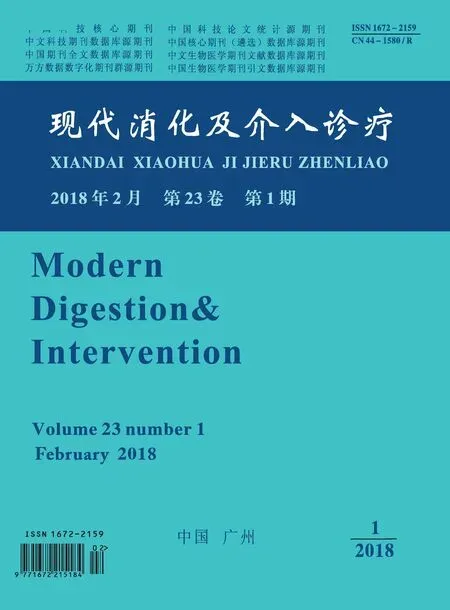直接经口胆道镜诊治胆道疾病的临床进展
吴静静 顾红祥 张亚历
自从1968年经内镜逆行性胰胆管造影术(ERCP)问世以来,ERCP已成为诊治胆道疾病的重要手段,但其不能直视胆道黏膜及取得活检,有一定的局限性。肝胆外科术中胆道镜探查、经T管窦道胆道镜及经皮经肝胆道镜技术能直视胆道黏膜,但均为有创操作。直接经口胆道镜 (Direct Peroral Cholangioscopy,DPOC)检查直观、微创,越来越受到临床重视。DPOC常用的技术包括胆道子母镜、超细内镜及Spy-Glass系统。随着技术的发展及系统的完善,DPOC的图像质量和可操作性得到了提高,DPOC发展迅速。本文就目前国内外直接经口胆道镜的分类及临床应用情况做一综述。
一、基于内镜的DPOC
1.胆道子母镜
1976年Nakajima等[1]验证了经口胆道镜的可行性,但临床真正的经口胆道镜技术始于Olympus公司的胆道子母镜系统。胆道子母镜需要两名熟练的内镜医师使用两个内镜系统进行操作,分别控制胆道镜和十二指肠镜[2]。方法为常规行ERCP乳头切开后,十二指肠镜作为母镜插至十二指肠降部上段,胆道镜作为子镜沿导丝通过母镜的钳道进入胆管然后进行下一步治疗。胆道子母镜的系统经历了从纤维内镜到电子内镜的发展过程。电子胆道子母镜图像清晰、易于进入胆道,常用于治疗胆管结石、不明原因胆管狭窄、明确管壁病变及黏膜异常的病因,其成功率及诊断率均较高。吴承荣等运用电子子母镜对23例患者进行治疗,插管成功率为95.65%,诊断率为100%[3]。但其也有需双人操作、易损坏、维修费用高、工作通道小(1.2 mm)等明显不足,技术条件要求较高,其应用的开展仅限于少数大型医疗中心。
2.超细内镜
1977年Urakami等[4]首次报道了使用纤维胃镜直接经口进入胆管进行检查的技术。超细内镜具有管径细、可操控性强、图像清晰、工作通道大的特点,是内镜医师最有兴趣,也最希望用于DPOC的工具。随着超细内镜作为经口胆道镜的临床应用,研究如何将其送入胆管,是近年来内镜技术研究的一大热点。
(1)锚定球囊+超细内镜:由于十二指肠的解剖学特点,徒手经口胆道镜的临床运用有一定的限制性,目前大多数的操作都需要通过特殊的辅助附件引导来增加成功率。Moon等[5]采用了胆管内球囊(5 Fr双腔锚定球囊)锚定导丝引导胃镜进入胆管的方法,成功率为95.2%。该技术的操作方法为ERCP乳头切开后,用十二指肠镜将导丝送至合适的肝内胆管,球囊通过导丝的引导进入肝管锚定后,撤出十二指肠镜,在导丝引导下超细内镜进入相应的胆管。胆管内球囊锚定法插入胆道的难度最低,然而,胆管扩张球囊必须是5 F的球囊,几乎占满了超细内镜2.0 mm的工作通道,当镜子进入胆管进行碎石等操作时,需撤出引导的球囊导管才能插入其他的辅助治疗附件,这时镜子失去了球囊的固定和牵引,其稳定性变差,从而会影响治疗。李健等[6]通过改良的锚定球囊+超细内镜较好地完成了12例DPOC,该方法将0.5334 mm导丝预先绑定于锚定球囊头端,超细内镜经锚定的导丝进入胆管,完成DPOC。由于0.5334 mm的导丝直径较小,可留有空间便于插入其他治疗附件,通过导丝固定内镜,使得内镜有良好的稳定性和操控性,保证了操作过程的顺利进行。但球囊锚定法有肝内胆管撕裂及空气栓塞的风险[7],在临床未获广泛开展。
(2)外套管+超细内镜:Choi等[8]采用双气囊小肠镜外套管辅助进镜的方法,成功进行了DPOC。首先将超细内镜插入外套管中,一起送至十二指肠球部,将外套管头端的气球充气固定后,再将内镜送至十二指肠乳头部,控制外套管后轻旋回撤内镜使内镜进入胆总管进行胆道镜检查。使用双气囊小肠镜外套管来固定超细内镜镜身,可以避免超细内镜在胃内盘曲,提高了超细内镜进入胆总管的成功率。Tsou等[9]进一步验证了该技术的可行性,成功率为100%。然而外套管内径为10.8 mm,相对超细内镜来讲直径过大,使得超细内镜在外套管腔内不稳定,不易完成操作。
(3)圈套器+超细内镜:黄永辉等[10]通过使用圈套器的牵引将内镜弯曲部送入胆管的方法对8例患者完成了检查(成功率100%),且无并发症。方法为ERCP下行乳头柱状球囊扩张后,将圈套器套住超细内镜弯曲部然后收紧,再一起送至乳头部,将超细内镜镜身对准胆道开口后轻微牵引圈套器再适当旋转镜身使得内镜进入胆管。该方法操作简单,可以大大地缩短操作时间,但是需要助手辅助牵拉圈套器才可完成操作。
(4)预弯曲的硬导丝+超细内镜:方法为提前将硬导丝预弯曲成一定角度用以减少十二指肠和胆总管之间的角度,行ERCP括约肌切开术后,硬导丝通过超细内镜的工作通道将预弯部位放置在内镜蛇行部,将导丝头端送入胆管,然后内镜可沿着预弯部分送入胆管。Callaghan等[11]报道了该方法,但是该报道中的样本量少,仍需更多研究来验证其安全性及有效性。
(5)其他:还有报道使用ERCP胆管导丝引导法、十二指肠球囊堵塞法等[12-14]辅助超细内镜进入胆管的方法,但是这些方法的成功率并不高。Itoi等[15]研制出一种新型的超细内镜完成DPOC,该内镜新增有两个弯曲部分(近端部分可上下90°偏转,远端部分可160°向上及100°向下偏转),通过2个部位的主动弯曲使内镜更易进入胆道,但是该方法仍需附件辅助进镜。
超细内镜作为经口胆道镜有其优势:可以获得良好的图像、工作通道孔径较大方便治疗、单人操作、便于取活检。但其需要附件辅助进镜、镜身在胆管内不稳定、镜身较大等也限制了其临床应用的开展。
二、基于导管的DPOC
1.SpyGlass胆道直视子镜系统
SpyGlass系统在2006年由波士顿科学公司引入市场。Chen等[16-17]在2007年首次介绍了SpyGlass系统。2012年Hammerle等[18]通过大样本研究证明了SpyGlass与ERCP相比,其并发症的发生率并没有增加,进一步证实了其安全性。其操作方法如下:十二指肠镜切开乳头后,留置导丝至病变位置以上,将光纤摄像头插入至传送导管,在导丝的引导下将传送导管通过十二指肠镜的工作孔道送入目标位置,最后退出引导导丝来进行下一步操作。SpyGlass系统主要用于胆胰管结石、不明原因胆管狭窄、胰管内肿瘤的诊断[19-21]。随着技术的发展及系统的应用,学者们开始逐渐将其应用于不同的领域,包括辅助无放射线ERCP取石[22]、在急性胆囊炎患者中选择性胆囊管支架引流[23]、通过结肠镜引导SpyGlass对Roux-en-Y术后患者行治疗性ERCP[24]等。Kurihara等[19]使用SpyGlass系统对148例胆胰疾病患者进行了前瞻性研究,在胆管及胰管疾病中的成功率分别为95.5%和88.2%,手术并发症发生率为5.4%,证明了使用SpyGlass系统治疗胆胰疾病的安全性和有效性。随着技术的改进,SpyGlass系统的成像技术也从纤维光学成像向电子光学成像发展[25]。第二代SpyGlass系统(SPY-DS),不仅镜下直视图像更加清晰,其活检的敏感性和特异性也明显提高[25-27]。SpyGlass系统可直视胆道黏膜、单人操作简单方便且可在正常胆管操作。但是其操作过程中易出现摄像头损坏,且其活检组织少在一定程度上会影响诊断。
2.其他
2010年德国开发出的PolyScope内镜系统,最初用于尿道系统疾病的诊治[28]。Cennamo等[29]将PolyScope内镜系统应用于胆道系统疾病的诊治。李春生等[30]使用PolyScope内镜系统对47例患者进行了诊治,无并发症发生,进一步证明了使用PolyScope内镜系统诊治胆道疾病的可行性。但是目前关于使用PolyScope内镜系统诊治胆道疾病的报道很少,其安全性和有效性仍有待验证。
三、DPOC的临床运用
在不明原因的胆管狭窄及肿瘤的诊治中,DPOC可直接观察病变的胆道黏膜及取得活检,其诊断恶性肿瘤的敏感度和特异度分别为86%~100%和64%~92%,活检组织的敏感度和特异度分别为38%~100%和96%~100%[31-33]。DPOC还可以用于治疗胆管结石,其碎石成功率为71%-100%[33-35]。还有报道可用于原发性硬化性胆管炎与恶性肿瘤的鉴别[36]、急性胆囊炎胆汁引流[23,37]、Roux-en-Y术后患者胆汁引流、取石[38-39]。利用3D技术与胆道镜相结合,用于诊断胆管乳头状癌[40]。其他还有激光消融胆管肿瘤、氩等离子体凝固胆管肿瘤、胆管囊肿的研究、不明原因胆管出血、移位胆管支架的移除等等也有报道。
四、DPOC的并发症
DPOC的并发症包括胆管炎、出血、缺氧、心律失常、空气栓塞和肝内外胆管穿孔等[7,41-42]。Thosani等[43]首次对单人操作胆道镜(SOC)导致菌血症及感染并发症的发生情况进行了前瞻性临床研究,结果约有28%的菌血症发生率,建议在行胆道镜操作前常规预防性使用抗菌药物。特别是对于老年患者、有胆道支架植入史患者及进行液电、激光碎石等高危患者,亦建议预防性使用抗生素。空气栓塞是DPOC的另一个严重并发症,操作中使用CO2可降低空气栓塞的风险,但亦有文献报道即便是使用CO2,仍可导致空气栓塞[44]。因此DPOC中,应使用胆道内注水辅助观察,避免使用空气、甚至CO2注气,以防止空气栓塞这种严重并发症的发生。
五、展望
目前ERCP是诊治胆道疾病的主要手段之一,但其对胆管黏膜的镜下直视及活检仍无法完成。而DPOC技术的问世弥补了ERCP的不足,可以更直观和有效的对胆道疾病进行诊治,同时减少了医患的放射损伤,临床意义重大。当然,目前DPOC仍有许多问题需要解决,包括如何提高成像质量、如何简单方便进入胆管、如何更好的应用NBI系统、如何完善3D技术与胆道镜结合技术等。随着内镜器械的研究及操作技术的进步,相信未来DPOC可以更好更广泛的得到应用。
[1]Nakajima M,Akasaka Y,Fukumoto K,et al.Peroral cholangiopancreatosocopy(PCPS)under duodenoscopic guidance[J].Am J Gastroenterol,1976,66(3):241-247.
[2]Nakajima M,Akasaka Y,Yamaguchi K,et al.Direct endoscopic visualization of the bile and pancreatic duct systems by peroral cholangiopancreatoscopy(PCPS)[J].Gastrointest Endosc,1978,24(4):141-145.
[3]吴承荣,刘运祥,黄留业,等.电子子母胆道镜在胆道疾病诊断中的应用[J].中华消化内镜杂志,2009,26(4):210-212.
[4]Urakami Y,Seifert E,Butke H.Peroral direct cholangioscopy(PDCS)using routine straight-view endoscope:first report[J].Endoscopy,1977,9(1):27-30.
[5]Moon JH,Ko BM,Choi HJ,et al.Intraductal balloon-guided direct peroral cholangioscopy with an ultraslim upper endoscope(with videos)[J].Gastrointest Endosc,2009,70(2):297-302.
[6]李健,郭绍举,张竞超,等.经口直接胆道镜治疗十二指肠镜取石困难患者的疗效观察(含视频)[J].中华消化内镜杂志,2015,32(1):24-28.
[7]Efthymiou M,Raftopoulos S,Antonio CJ,et al.Air embolism complicated by left hemiparesis after direct cholangioscopy with an intraductal balloon anchoring system[J].Gastrointest Endosc,2012,75(1):221-223.
[8]Choi HJ,Moon JH,Ko BM,et al.Overtube-balloon-assisted direct peroral cholangioscopy by using an ultra-slim upper endoscope(with videos)[J].Gastrointest Endosc,2009,69(4):935-940.
[9]Tsou YK,Lin CH,Tang JH,et al.Direct peroral cholangioscopy using an ultraslim endoscope and overtube balloon-assisted technique:a case series[J].Endoscopy,2010,42(8):681-684.
[10]黄永辉,常虹,姚炜,等.圈套器辅助超细胃镜实施经口直接胆道镜技术的初步应用[J].中华消化内镜杂志,2015,32(2):86-88.
[11]Callaghan JL,Longcroft-Wheaton G,Fowell AJ,et al.A novel technique for peroral direct cholangioscopy[J].Endoscopy,2014,46(1):E672-673.
[12]Larghi A,Waxman I.Endoscopic direct cholangioscopy by using an ultra-slim upper endoscope:a feasibility study[J].Gastrointest Endosc,2006,63(6):853-857.
[13]苏军凯,陈玲,闵培,等.超细胃镜作为经口胆道镜应用的临床初步研究[J].中华临床医师杂志(电子版),2014,(8):1498-1501.
[14]Mori A,Ohashi N,Nozaki M,et al.Feasibility of duodenal balloon-assisted direct cholangioscopy with an ultrathin upper endoscope[J].Endoscopy,2012,44(11):1037-1044.
[15]Itoi T,Nageshwar RD,Sofuni A,et al.Clinical evaluation of a prototype multi-bending peroral direct cholangioscope[J].Dig Endosc,2014,26(1):100-107.
[16]Chen YK,Pleskow DK.SpyGlass single-operator peroral cholangiopancreatoscopy system for the diagnosis and therapy of bileduct disorders:a clinical feasibility study(with video)[J].Gastrointest Endosc,2007,65(6):832-841.
[17]Chen YK. Preclinical characterization of the Spyglass peroral cholangiopancreatoscopy system for direct access, visualization,and biopsy[J].Gastrointest Endosc,2007,65(2):303-311.
[18]Hammerle CW,Haider S,Chung M,et al.Endoscopic retrograde cholangiopancreatography complications in the era of cholangioscopy:is there an increased risk?[J].Dig Liver Dis,2012,44(9):754-758.
[19]Kurihara T,Yasuda I,Isayama H,et al.Diagnostic and therapeutic single-operator cholangiopancreatoscopy in biliopancreatic diseases:Prospective multicenter study in Japan[J].World J Gastroenterol,2016,22(5):1891-1901.
[20]Fishman DS,Tarnasky PR,Patel SN,et al.Management of pancreaticobiliary disease using a new intra-ductal endoscope:the Texas experience[J].World J Gastroenterol,2009,15(11):1353-1358.
[21]Draganov PV,Chauhan S,Wagh MS,et al.Diagnostic accuracy of conventional and cholangioscopy-guided sampling of indeterminate biliary lesions at the time of ERCP:a prospective,long-term follow-up study[J].Gastrointest Endosc,2012,75(2):347-353.
[22]Shelton J,Linder JD,Rivera-Alsina ME,et al.Commitment,confirmation,and clearance:new techniques for nonradiation ERCP during pregnancy(with videos)[J].Gastrointest Endosc,2008,67(2):364-368.
[23]Barkay O,Bucksot L,Sherman S.Endoscopic transpapillary gallbladder drainage with the SpyGlass cholangiopancreatoscopy system[J].Gastrointest Endosc,2009,70(5):1039-1040.
[24]Baron TH,Saleem A.Intraductal electrohydraulic lithotripsy by using SpyGlass cholangioscopy through a colonoscope in a patient with Roux-en-Y hepaticojejunostomy[J].Gastrointest Endosc,2010,71(3):650-651.
[25]Imanishi M,Ogura T,Kurisu Y,et al.A feasibility study of digital single-operator cholangioscopy for diagnostic and therapeutic procedure(with videos)[J].Medicine(Baltimore),2017,96(15):e6619.
[26]Navaneethan U,Hasan MK,Lourdusamy V,et al.Single-operator cholangioscopy and targeted biopsies in the diagnosis of indeterminate biliary strictures:a systematic review[J].Gastrointest Endosc,2015,82(4):608-614,e602.
[27]Navaneethan U,Hasan MK,Kommaraju K,et al.Digital,singleoperator cholangiopancreatoscopy in the diagnosis and management of pancreatobiliary disorders: a multicenter clinical experience(with video)[J].Gastrointest Endosc,2016,84(4):649-655.
[28]Bader MJ,Gratzke C,Walther S,et al.The PolyScope:a modular design,semidisposable flexible ureterorenoscope system[J].J Endourol,2010,24(7):1061-1066.
[29]Cennamo V,Luigiano C,Fabbri C,et al.Cholangioscopy using a new type of cholangioscope for the diagnosis of biliary tract disease:a case series[J].Endoscopy,2012,44(9):878-881.
[30]Li C,Chen J,Zhang J,et al.Management of biliary and pancreatic diseases using a new intraductal endoscope[J].J Laparoendosc Adv Surg Tech A,2014,24(3):130-133.
[31]Nishikawa T,Tsuyuguchi T,Sakai Y,et al.Comparison of the diagnostic accuracy of peroral video-cholangioscopic visual findings and cholangioscopy-guided forceps biopsy findings for indeterminate biliary lesions:a prospective study[J].Gastrointest Endosc,2013,77(2):219-226.
[32]Woo YS,Lee JK,Oh SH,et al.Role of SpyGlass peroral cholangioscopy in the evaluation of indeterminate biliary lesions[J].Dig Dis Sci,2014,59(10):2565-2570.
[33]Sioulas AD,El-Masry MA,Groth S,et al.Prospective evaluation of the short access cholangioscopy for stone clearance and evaluation of indeterminate strictures[J].Hepatobiliary Pancreat Dis Int,2017,16(1):96-103.
[34]Maydeo A,Kwek BE,Bhandari S,et al.Single-operator cholangioscopy-guided laser lithotripsy in patients with difficult biliary and pancreatic ductal stones(with videos)[J].Gastrointest Endosc,2011,74(6):1308-1314.
[35]Patel SN,Rosenkranz L,Hooks B,et al.Holmium-yttrium aluminum garnet laser lithotripsy in the treatment of biliary calculi using single-operator cholangioscopy:a multicenter experience(with video)[J].Gastrointest Endosc,2014,79(2):344-348.
[36]Arnelo U,von Seth E,Bergquist A.Prospective evaluation of the clinical utility of single-operator peroral cholangioscopy in patients with primary sclerosing cholangitis[J].Endoscopy,2015,47(8):696-702.
[37]Shin JU,Lee JK,Kim KM,et al.Endoscopic naso-gallbladder drainage by using cholangioscopy for acute cholecystitis combined with cholangitis or choledocholithiasis(with video)[J].Gastrointest Endosc,2012,76(5):1052-1055.
[38]Matsumoto K,Tsutsumi K,Baba Y,et al.Successful biliary drainage with peroral direct cholangioscopy in a patient with Roux-en-Y hepaticojejunostomy for congenital biliary dilatation[J].Endoscopy,2015,47(Suppl 1):E497-498.
[39]Kawakami H,Kuwatani M,Kubota Y,et al.Endoscopic ultrasound-guided antegrade bile duct stone treatment followed by direct peroral transhepatic cholangioscopy in a patient with Rouxen-Y reconstruction[J].Endoscopy,2015,47(Suppl 1):E340-341.
[40]Weigt J,Pech M,Malfertheiner P.Virtual 3D-cholangioscopy:Correlation with direct peroral cholangioscopy in a patient with papillary cholangiocarcinoma[J].Dig Endosc,2017,29(1):123.
[41]Farnik H,Weigt J,Malfertheiner P,et al.A multicenter study on the role of direct retrograde cholangioscopy in patients with inconclusive endoscopic retrograde cholangiography[J].Endoscopy,2014,46(1):16-21.
[42]Sethi A,Chen YK,Austin GL,et al.ERCP with cholangiopancreatoscopy may be associated with higher rates of complications than ERCP alone:a single-center experience[J].Gastrointest Endosc,2011,73(2):251-256.
[43]Thosani N,Zubarik RS,Kochar R,et al.Prospective evaluation of bacteremia rates and infectious complications among patients undergoing single-operator choledochoscopy during ERCP[J].Endoscopy,2016,48(5):424-431.
[44]Kondo H,Naitoh I,Nakazawa T,et al.Development of fatal systemic gas embolism during direct peroral cholangioscopy under carbon dioxide insufflation[J].Endoscopy,2016,48(Suppl 1):E215-216.

